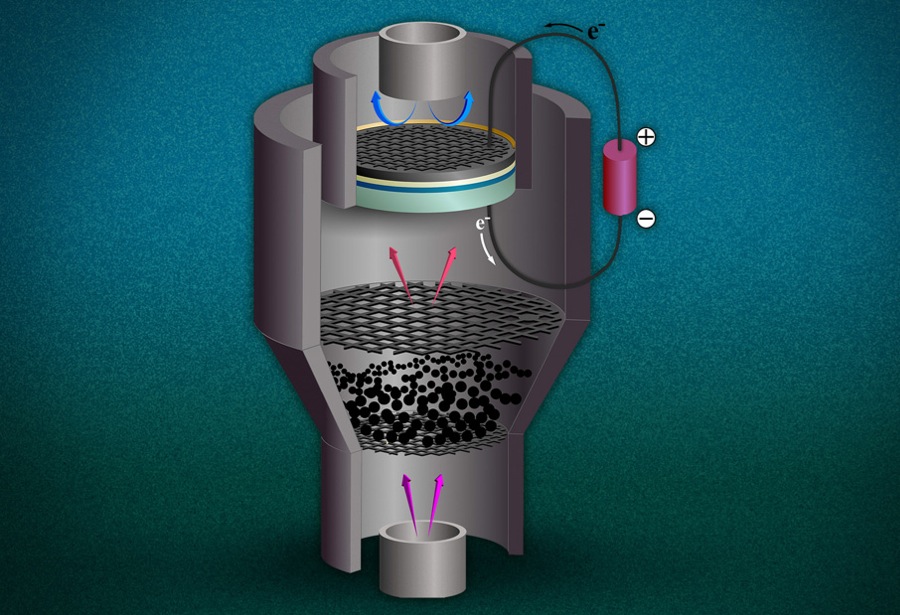
Possible configuration for the combined system proposed by MIT researchers. ( Illustration: Jeffrey Hanna |MIT)
Only three months after world leaders meeting in Paris signed a sweeping deal to reduce greenhouse gas emissions, a team of American scientists has designed a hybrid system that could boost efficiency of coal-powered plants, cutting emissions in half.
Researchers at the Massachusetts Institute of Technology (MIT) are proposing a combined system that has the potential to generate electricity from coal with much greater efficiency — possibly reaching as much as twice the fuel-to-electricity efficiency of today’s conventional coal plants, according to the paper to be published in the May edition of The Journal of Power Sources.
The only way to realistically cut down on carbon dioxide emissions is to increase the efficiency of our fossil fuel plants, MIT researchers say.
If that proves to be possible, it would mean a 50% reduction in carbon dioxide emissions for a given amount of power produced.
“If we’re going to cut down on carbon dioxide emissions in the near term, the only way to realistically do that is to increase the efficiency of our fossil fuel plants,” MIT doctoral student Katherine Ong said in a statement.
The key, the scientists explain, is combining into a single system two well-known technologies — coal gasification and fuel cells:
Coal gasification, by itself, works at a lower temperature than combustion and is more efficient than burning. First, the coal is pulverized to a powder, which is then heated in a flow of hot steam, somewhat like popcorn kernels heated in an air-popper. The heat leads to chemical reactions that release gases from the coal particles — mainly carbon monoxide and hydrogen, both of which can produce electricity in a solid oxide fuel cell.
In the combined system, these gases would then be piped from the gasifier to a separate fuel cell stack, or ultimately, the fuel cell system could be installed in the same chamber as the gasifier so that the hot gas flows straight into the cell. In the fuel cell, a membrane separates the carbon monoxide and hydrogen from the oxygen, promoting an electrochemical reaction that generates electricity without burning the fuel.
Because there is no burning involved, the system produces less ash and other air pollutants than would be generated by combustion. It does produce carbon dioxide, but this is in a pure, uncontaminated stream and not mixed with air as in a conventional coal-burning plant.
David Tucker, a research scientist at the U.S. Department of Energy’s National Energy Technology Laboratory in West Virginia, agrees. While he was not involved in the MIT research, he believes that exploring unconventional hybrid cycles represents the future of clean energy production in the US.
According to projections by the International Energy Agency (IEA) even with the new agreements in place, global coal-fired power generation will increase over the next few decades. Finding a cleaner way of using that coal, the MIT experts said, could be a significant step toward achieving carbon-emissions reductions while meeting the needs of a growing and increasingly industrialized world population.
6 Comments
Petrus Keramos
This is excellent news! It is the dirt burning of coal which is responsable for the climate change as the fine particles in smoke give rise to smog and long staying fog preventing the earth to cool down during the night. The pure CO2 is no harm for the climate although Al Gore, Obama and the Pope think otherwise but they are simply wrong.
Prevent wild fires dirty cars and untrolled burning of coal! The quality of live will be strongly improved if we can reach this goal. Petrus Keramos
vcs
there are so many intricacies in coal gassification, using oxygen or steam. all the coal will not get converted in to gas, all types of coals are not suitable for gassification. its a beginning. the researchers has to work with plant engineers like us to find a better alternatives.
Nate Blair
While a gasified fuel cell is an excellent goal, the headline is misleading. This system cannot be used on the vast bulk of existing coal capacity nor on the coal capacity being built in the developing world today. So, you would have this new build coal plant with a fuel cell in competition to be built with a gas turbine, solar, wind, nuclear. while a step forward on the potential use of coal, it certainly doesn’t have the potential to cut current emissions by 50%
The Real John Smith
I agree with Nate Blair, trying to integrate this as a retrofit would probably not be cost-effective. However there are at least a few generators out there with enough future to integrate this type of technology into new construction or maybe even full-train rebuilds.
Altaf
@ Nate Blair, Smith. This is not an upgradation of existing boiler system like super critical technology. It is an entirely new concept which generates electricity without burning fuel. This system can not be integrated with existing B/T/G process. Its an entirely new concept which will take its own time to develop. First the researchers need to find financiers to install pilot plants, study the system, then grow to commercial plants. Once the process is established, coal fired power plants will be replaced with this new concept. It takes about 25-40 years for any new concept to be accepted as a mainstream technology globally (if everything works well as planned)
hebintn
Not an expert, but the process described here must take a huge amount of energy compared to just burning coal. So, what is the energy balance? Is it really an efficient use of the energy in coal to have to use half(?) the energy to generate some electrons? Don’t just huff and puff, show me the data from an unbiased source. Of course none of this addresses the environmental disaster that coal extraction, processing, transportation, waste, and GHG to name a few, represents.